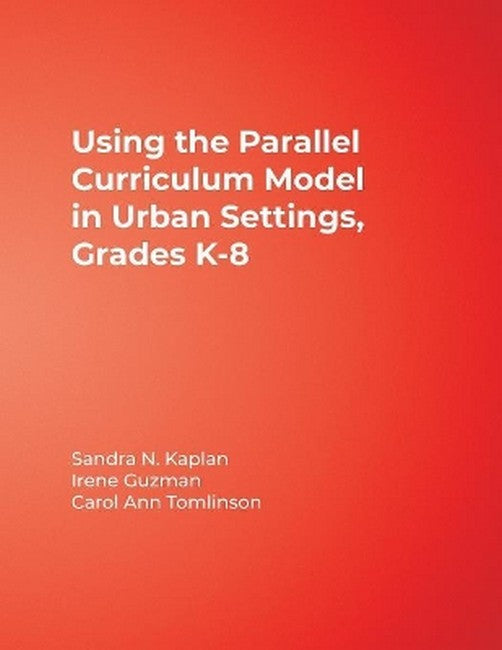Sandra N. Kaplan has been a teacher and administrator of gifted programs in an urban school district in California. Currently, she is clinical professor in learning and instruction at the University of Southern California's Rossier School of Education. She has authored articles and books on the nature and scope of differenti-ated curriculum for gifted students. Her primary area of concern is modifying the core and differentiated curriculum to meet the needs of inner-city, urban, gifted learners. She is a past president of the California Association for the Gifted (CAG) and the National Asso-ciation for Gifted Children (NAGC). She has been nationally recognized for her con-tributions to gifted education. Irene Guzman has been teaching in the Santa Unified School District for 14 years. She is currently teaching third grade at Heninger Elementary School. She has dedicated her efforts to differentiate the curriculum for gifted English language learners. She has worked closely with teachers to improve support for the specific needs of gifted students in the urban setting. Guzman has worked under the USC Javits Grant as a mentor and a coach. She has also been a demonstration teacher and presenter at the California Association for the Gifted Conference and the USC summer institutes. Carol Ann Tomlinson's career as an educator includes 21 years as a public school teacher. She taught in high school, preschool, and middle school, and worked with heterogeneous classes as well as special classes for students identified as gifted and students with learning difficulties. Her public school career also included 12 years as a program administrator of special services for advanced and struggling learners. She was Virginia's Teacher of the Year in 1974. She is professor of educational leadership, foundations, and pol-icy at the University of Virginia's Curry School of Education; a researcher for the National Research Center on the Gifted and Talented; a codirec-tor of the University of Virginia's Summer Institute on Academic Diversity; and president of the National Association for Gifted Children. Special interests through-out her career have included curriculum and instruction for advanced learners and struggling learners, effective instruction in heterogeneous settings, and bridging the fields of general education and gifted education. She is author of over 100 articles, book chapters, books, and other professional development materials, including How to Differentiate Instruction in Mixed-Ability Classrooms, The Differentiated Classroom: Responding to the Needs of All Learners, Leadership for Differentiated Schools and Classrooms, the facilitator's guide for the video staff development sets called Differentiating Instruction, and At Work in the Differentiated Classroom, as well as a professional inquiry kit on differentiation. She works throughout the United States and abroad with teachers whose goal is to develop more responsive heterogeneous classrooms.
Request Academic Copy
Please copy the ISBN for submitting review copy form
Description
Preface: Bridging the Gap Acknowledgments About the Authors Introduction: The Purposes of the Parallel Curriculum Model Multiple Applications and the Parallel Curriculum Model Flexibility of the Parallel Curriculum Model Structure of the Parallel Curriculum Model Responding to Student Diversity With Curriculum Diversity Urban Classroom Dynamics Developing an Academic Skill Set Introduction to the PCM Focus Lessons Lesson Plan Format Implementing the Lesson Plan Lesson Plan Scheduling Depth and Complexity 1. Scholarly Dispositions Lesson A: Developing an Interest (I) Lesson B: Developing an Interest (II) Lesson C: Developing Tenacity Lesson D: Determining Relevance Lesson E: Confronting Failure Lesson F: Intellectual Strengths Lesson G: Receptivity to Experience 2. Participation Skills Lesson A: Questioning Lesson B: Asking for Clarification Lesson C: Restating Lesson D: Acknowledging Peers 3. Self-Advocacy Lesson A: Establishing a Voice Lesson B: Building Confidence Lesson C: Establishing an Identity Lesson D: Multiple Group Membership 4. Presentation Skills Lesson A: Talking Steps Lesson B: Ways to Say It Lesson C: Engaging the Audience Lesson D: Staying on Target Appendix A: Designing Curriculum Using the Parallel Curriculum Model Appendix B: Teaching the Prompts of Depth and Complexity References Index
"My experience teaching the lessons to students helped me understand the importance of self-reflection. The students were able to reflect on their own abilities in learning. The opportunity to define themselves as learners is informative and empowering." -- Robert Grubb, Teacher "Teaching students how to be 'lifelong learners' can be realized by helping them develop a sense of responsibility for their learning. These lessons provide that opportunity for students." -- Paige A. McGinty, Doctoral Student in Teacher Education, Multicultural Societies

